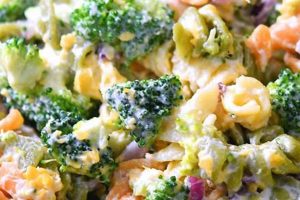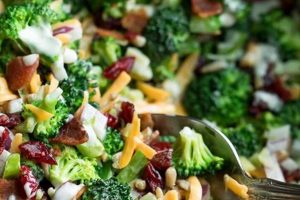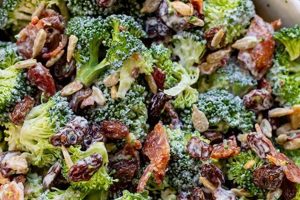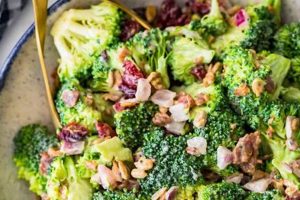A low-carbohydrate variation of the classic side dish, this type of salad typically features broccoli as the main ingredient, combined with other keto-friendly components such as high-fat cheeses, nuts, seeds, and a creamy, low-carb dressing. A typical example might include raw or blanched broccoli florets, crumbled bacon, shredded cheddar cheese, sunflower seeds, and a mayonnaise-based dressing seasoned with vinegar and spices.
This dish offers a nutritious and flavorful way to enjoy broccoli while adhering to the principles of a ketogenic diet. By replacing high-carb ingredients like dried fruit or sugary dressings with healthy fats and proteins, it helps maintain the state of ketosis, where the body burns fat for fuel. This approach aligns with dietary restrictions focusing on low carbohydrate intake, making such salads a popular choice for those managing weight, blood sugar levels, or following specific dietary plans. The increasing popularity of low-carb lifestyles has led to numerous variations, accommodating diverse tastes and dietary needs.
The following sections will delve into specific ingredient choices, preparation techniques, and nutritional information for crafting delicious and healthful versions of this dish.
Tips for Creating a Delicious Low-Carb Broccoli Salad
Achieving optimal flavor and texture requires careful consideration of ingredient selection and preparation techniques. The following tips offer guidance for creating a successful and satisfying dish.
Tip 1: Blanch the Broccoli: Briefly submerging broccoli florets in boiling water, followed by an ice bath, enhances color and texture while maintaining a crisp-tender consistency. Overcooking can lead to a mushy texture.
Tip 2: Choose High-Quality Fats: Opt for flavorful oils like extra virgin olive oil or avocado oil for the dressing base. Incorporating healthy fats from sources such as avocado, nuts, and seeds enhances both flavor and nutritional value.
Tip 3: Explore Flavor Combinations: Consider incorporating ingredients like red onion, chopped bacon, toasted almonds, sunflower seeds, or shredded cheddar cheese for added flavor and texture. Experimentation with different combinations can lead to unique and satisfying results.
Tip 4: Balance Flavor Profiles: Achieve a balanced flavor profile by incorporating acidic components like vinegar or lemon juice to complement the richness of the fats and the savory notes of other ingredients.
Tip 5: Properly Store Leftovers: Store leftover salad in an airtight container in the refrigerator for up to three days. The texture of the broccoli may soften slightly over time.
Tip 6: Consider Raw Broccoli for Added Crunch: While blanching enhances color and tenderness, using raw broccoli florets offers a distinctly crisp and crunchy texture.
Tip 7: Customize to Dietary Needs: This dish can be readily adapted to accommodate various dietary restrictions. Vegan versions can be achieved using plant-based mayonnaise and omitting dairy-based cheeses.
By following these tips, one can create a delicious and healthful salad that complements a variety of meal plans. Careful attention to detail ensures a satisfying culinary experience.
The following section will provide concluding remarks and summarize the key benefits of incorporating this versatile dish into one’s diet.
1. Low-Carb Ingredients
Ingredient selection is paramount in a ketogenic diet, particularly for dishes like broccoli salad. Low-carbohydrate options form the foundation of such recipes, ensuring the dish aligns with dietary restrictions and promotes ketosis. Understanding the role of these ingredients is crucial for creating a successful and satisfying meal.
- Cruciferous Vegetables:
Broccoli, cauliflower, and Brussels sprouts are excellent low-carb choices, offering nutritional value and textural diversity. Broccoli, the star ingredient in this context, provides fiber and essential vitamins. Cauliflower can be riced and used as a substitute for grains, while Brussels sprouts can be roasted or shredded for added flavor and texture. These vegetables form a substantial base for the salad.
- Healthy Fats:
Avocados, nuts, seeds, and cheeses contribute healthy fats and flavor while promoting satiety. Avocado oil in the dressing adds creaminess, while slivered almonds or sunflower seeds offer crunch. Full-fat cheeses like cheddar or provolone provide savory notes. These ingredients are essential for maintaining ketosis and enhancing the salad’s overall appeal.
- Low-Carb Dressings:
Traditional dressings often contain high-carb ingredients like sugar or honey. Keto-friendly alternatives utilize ingredients such as mayonnaise, sour cream, vinegar, and low-carb sweeteners like stevia or erythritol. These dressings provide flavor without compromising dietary goals. A well-balanced dressing enhances the other ingredients while ensuring the salad remains low in carbohydrates.
- Flavor Enhancers:
Ingredients like fresh herbs, spices, lemon juice, and garlic add depth and complexity without adding significant carbohydrates. Chopped chives, red pepper flakes, or a squeeze of lemon can elevate the flavor profile. These additions ensure the salad remains flavorful and appealing within the constraints of a ketogenic diet.
Careful selection of low-carb ingredients allows for the creation of a flavorful and satisfying broccoli salad that adheres to the principles of a ketogenic diet. The interplay of these components contributes not only to nutritional value but also to the overall sensory experience, ensuring the dish is both healthy and enjoyable.
2. Healthy Fats
Healthy fats constitute a cornerstone of ketogenic diets and play a vital role in broccoli salad recipes tailored to this dietary approach. The ketogenic diet drastically reduces carbohydrate intake, forcing the body to shift from using glucose to using fat as its primary fuel source. This metabolic state, known as ketosis, necessitates sufficient dietary fat intake to provide the body with energy. In a ketogenic broccoli salad, healthy fats contribute significantly to this requirement. They provide satiety, enhance flavor, and aid in the absorption of fat-soluble vitamins present in the broccoli and other salad components. Examples of suitable fats include monounsaturated fats found in avocado oil and olive oil, and polyunsaturated fats present in nuts and seeds like almonds, walnuts, and sunflower seeds. These fats not only contribute to the nutritional profile of the salad but also create a more palatable and satisfying meal.
The inclusion of healthy fats goes beyond simply meeting caloric needs. They contribute to the overall texture and mouthfeel of the salad, making it more enjoyable and less likely to feel like a dietary restriction. For example, avocado oil contributes a creamy texture to the dressing, while chopped nuts add a satisfying crunch. Furthermore, fats play a crucial role in satiety signaling, helping to regulate appetite and prevent overeating, a significant factor in weight management, a common objective for individuals following a ketogenic diet. The absence of sufficient healthy fats can lead to feelings of hunger and cravings, potentially undermining adherence to the diet.
Careful consideration of fat sources is essential for maximizing the benefits of a ketogenic broccoli salad. Prioritizing sources of unsaturated fats over saturated fats is generally recommended for overall health. Additionally, portion control remains important, even with healthy fats, as excessive caloric intake can hinder weight loss goals. Understanding the role and importance of healthy fats within the context of a ketogenic broccoli salad allows for informed ingredient choices and contributes to a more successful and sustainable dietary approach.
3. Flavor Balance
Flavor balance is crucial for a palatable and satisfying keto broccoli salad. The inherent flavors of raw broccolislightly bitter and vegetalrequire careful balancing through other ingredients. A ketogenic diet restricts high-carbohydrate ingredients typically used for sweetness or tang, such as dried fruits or sugary dressings. Therefore, achieving balance relies on strategic use of low-carb alternatives. Acidity, saltiness, umami, and subtle sweetness must be harmonized without relying on traditional flavoring agents. For instance, the sharpness of vinegar or lemon juice can cut through the richness of mayonnaise and cheese, while the addition of bacon or toasted nuts provides savory depth and textural contrast. This interplay of contrasting flavors ensures the salad isn’t overly bitter or bland.
Achieving this balance often involves experimentation. The intensity of flavors can vary based on ingredient quality and personal preferences. Starting with a base of high-quality mayonnaise and incorporating small amounts of acidic ingredients like apple cider vinegar or red wine vinegar allows for gradual adjustment. Taste testing at each stage helps prevent over-acidification or excessive saltiness. Adding spices like garlic powder, onion powder, or red pepper flakes can further enhance the complexity of the flavor profile. The interplay of fats, acids, spices, and savory additions creates a well-rounded flavor profile that elevates the simple ingredients. A well-balanced salad will offer a combination of creamy, crunchy, tangy, and savory notes.
Mastering flavor balance significantly impacts the overall enjoyment and sustainability of a ketogenic diet. A bland or unappetizing salad can lead to diet fatigue and potential non-compliance. By understanding the principles of flavor balance and employing practical techniques, individuals can create delicious and satisfying keto-friendly meals, increasing adherence to dietary guidelines and promoting long-term success. This attention to detail transforms a potentially restrictive diet into a flavorful and enjoyable culinary experience.
4. Fresh Broccoli
Fresh broccoli plays a critical role in a successful broccoli salad keto recipe, impacting both flavor and nutritional value. Its selection and preparation significantly influence the final dish’s quality, affecting texture, color, and overall palatability. This section explores the multifaceted importance of fresh broccoli in this specific culinary context.
- Nutritional Value
Fresh broccoli offers a rich array of vitamins, minerals, and antioxidants, aligning with the health-conscious nature of ketogenic diets. These nutrients remain most potent in fresh produce, contributing to overall well-being. Vitamin C, vitamin K, and folate are particularly abundant in broccoli, supporting various bodily functions. Utilizing fresh broccoli maximizes these nutritional benefits within the ketogenic framework.
- Textural Impact
Fresh broccoli provides a crisp, tender texture when properly prepared, contrasting with other salad components. This textural element enhances the sensory experience of the dish. Blanching preserves this desirable texture, creating a pleasant contrast to creamy dressings and crunchy nuts or seeds often included in keto-friendly versions. Overcooked broccoli, conversely, yields a mushy texture that detracts from the overall appeal.
- Flavor Profile
Fresh broccoli possesses a slightly sweet and vegetal flavor, less pronounced than its cooked counterpart. This mild flavor provides a neutral backdrop for other ingredients, allowing the flavors of the dressing and additional components to shine. Freshness minimizes bitterness sometimes associated with older or improperly stored broccoli. This nuanced flavor profile contributes to the overall balance and complexity of the salad.
- Visual Appeal
Vibrant green color indicates freshness, enhancing the visual appeal of the salad. This vibrancy contributes to a more appetizing presentation, encouraging consumption. Fresh broccoli’s deep green hue contrasts attractively with other colorful ingredients commonly used in keto broccoli salads, such as red onion, bacon bits, or colorful cheeses. This visual element elevates the dining experience, making the dish more enticing.
These facets demonstrate the integral role of fresh broccoli in a keto broccoli salad recipe. Selecting fresh, high-quality broccoli ensures optimal nutritional value, desirable texture, balanced flavor, and an appealing presentation, contributing significantly to the dish’s overall success within a ketogenic dietary approach. Prioritizing freshness elevates this simple salad to a flavorful and nutritious component of a balanced ketogenic meal plan.
5. Versatile Preparation
Versatile preparation methods significantly enhance the adaptability of broccoli salad within a ketogenic dietary framework. This flexibility accommodates individual preferences and dietary needs while maximizing the nutritional benefits of broccoli. The ability to modify preparation techniques allows for variations in texture, flavor, and overall presentation, ensuring the dish remains appealing and sustainable as part of a long-term dietary plan. This versatility also facilitates the incorporation of various other keto-compatible ingredients, broadening the potential flavor profiles and nutritional content.
Several preparation methods exemplify this versatility. Raw broccoli retains maximum crispness and nutritional integrity, offering a crunchy texture that contrasts with softer ingredients. Blanching, involving brief submersion in boiling water followed by an immediate ice bath, enhances the vibrant green color while maintaining a tender-crisp texture. Roasting, achieved by tossing florets with olive oil and seasonings before baking, imparts a caramelized sweetness and intensifies the flavor profile. Each method produces a distinct sensory experience, catering to different preferences and offering variety within a ketogenic meal plan. For example, raw broccoli might be preferred in a salad emphasizing fresh, crisp flavors, while roasted broccoli might complement a heartier, more robust flavor profile. This adaptability also simplifies meal prepping, allowing for batch preparation of broccoli that can be incorporated into salads throughout the week using different flavor combinations and dressings.
The versatility of broccoli preparation within the ketogenic context extends beyond individual meals. It facilitates creativity and customization, preventing dietary monotony, a common challenge in restrictive eating patterns. This adaptability also proves beneficial when incorporating seasonal variations or accommodating ingredient availability. The ability to modify preparation methods based on available resources ensures a sustainable and adaptable approach to maintaining a ketogenic diet, maximizing both enjoyment and adherence to dietary principles.
Frequently Asked Questions
This section addresses common inquiries regarding the preparation and consumption of keto-friendly broccoli salad, providing clarification and guidance for those seeking to incorporate this dish into a ketogenic lifestyle.
Question 1: Can commercially prepared dressings be used in a keto broccoli salad?
Commercially prepared dressings often contain added sugars and high-carbohydrate ingredients incompatible with a ketogenic diet. Careful label scrutiny is essential to ensure minimal carbohydrate content. Opting for homemade dressings using keto-approved ingredients offers greater control over ingredients and macronutrient ratios.
Question 2: How can the shelf life of keto broccoli salad be extended?
Proper storage in an airtight container in the refrigerator helps maintain freshness for up to three days. However, the texture of the broccoli may soften over time. Freezing is not recommended, as it significantly alters the texture of the broccoli and other ingredients.
Question 3: What are suitable alternatives to mayonnaise in the dressing for those with dietary restrictions or preferences?
Full-fat Greek yogurt or sour cream can serve as alternatives to mayonnaise, offering a tangier flavor profile while remaining relatively low in carbohydrates. Avocado-based dressings also provide a creamy texture and healthy fats.
Question 4: How can the flavor of raw broccoli be mitigated if blanching is not preferred?
Marinating raw broccoli florets in a mixture of olive oil, lemon juice, and spices for a short period can mellow the raw flavor while enhancing overall palatability.
Question 5: Can other vegetables be included in a keto broccoli salad?
Keto-friendly vegetables like cauliflower, bell peppers, and shredded Brussels sprouts can complement broccoli, adding nutritional variety and textural complexity. However, total carbohydrate content should be considered to maintain dietary adherence.
Question 6: What are the key considerations for maintaining nutritional balance in a keto broccoli salad?
Balancing healthy fats, protein from sources such as cheese, nuts, or seeds, and fiber from the broccoli itself ensures a nutritionally complete meal. Adequate electrolyte intake should also be maintained within the overall ketogenic diet.
Understanding these key aspects contributes to successful preparation and enjoyment of keto-friendly broccoli salad as a healthy and sustainable component of a ketogenic lifestyle.
The following section offers a concluding summary of the key takeaways and benefits of incorporating keto broccoli salad into a balanced ketogenic diet.
Broccoli Salad Keto Recipe
Exploration of the broccoli salad keto recipe reveals a dish adaptable to dietary restrictions while offering nutritional value and culinary satisfaction. Emphasis on fresh, high-quality ingredients, balanced flavor profiles, and appropriate fat incorporation contributes to a successful ketogenic meal component. Versatile preparation methods further enhance adaptability, accommodating individual preferences and dietary needs. Careful consideration of low-carbohydrate ingredients, healthy fat sources, and flavor balancing ensures the recipe aligns with ketogenic principles while maximizing palatability.
Broccoli salad’s adaptability within the ketogenic framework underscores the potential for creative, healthful, and enjoyable meals despite dietary restrictions. Culinary exploration within specific dietary parameters encourages informed food choices, potentially fostering long-term dietary adherence and a deeper understanding of nutritional principles. This approach transforms dietary limitations into opportunities for culinary innovation and mindful eating.






